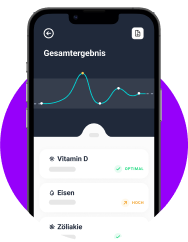30% of the world’s population suffers from iron deficiency – making iron deficiency one of the most common deficiency symptoms. An iron deficiency means that the human body does not produce enough hemoglobin. Hemoglobin, the red blood pigment, is found in the red blood cells. Without this substance, the body cannot bind and transport enough oxygen.
How you can recognize whether you suffer from iron deficiency, what the causes are and further information on the subject of iron deficiency can be found in this article.


Of the three to four grams of iron in the body, part is bound to transferrin, the transport protein. Another part is found in hemoglobin, the red blood pigment in red blood cells.
A balanced diet should contain 10 to 15 milligrams of iron. However, the intestine can only absorb five to ten percent of it. Depending on gender, age and life situation, the body loses different amounts of iron, which must be replaced. After the menopause, men and women lose about one milligram a day. Menstruating women lose up to three milligrams of iron during menstruation. The body of breastfeeding women also needs a higher amount of iron during the breastfeeding period.
The German Nutrition Society recommends the following amounts for iron intake:
An iron deficiency occurs when the iron requirement is greater than the intake. It can occur, for example, if not enough iron is absorbed through food or if the body’s iron absorption is impaired. Increased iron loss can also be the cause of iron deficiency.
In Europe, the most common cause of iron deficiency is chronic blood loss. Bleeding in the gastrointestinal tract, e.g. due to gastritis, is one of the most common causes. Menstruation is also a common reason for the deficiency.
A meat-free or too one-sided diet can also lead to deficiency symptoms. Infants, small children, alcoholics, vegetarians and vegans are most likely to be affected.
If the body’s iron absorption is impaired, the body cannot absorb iron from food properly. This could be triggered by chronic inflammatory bowel disease, for example. Impaired iron absorption can also occur after partial removal of the stomach. Prolonged use of medication against excessive stomach acid production can hinder iron absorption. A high consumption of black tea or coffee and rhubarb also leads to inhibited iron absorption.
Our body needs iron to transport oxygen. The body also needs iron for blood formation and other metabolic processes. If the body is not supplied with enough iron, this is reflected in the following symptoms, among others:
Iron deficiency depletes the body’s iron stores. This is emptied until all reserves are exhausted. Until then, for example, symptoms of exhaustion occur. This is followed by iron deficiency anemia.
The body cannot function properly with an iron deficiency – the immune system also suffers as a result. In addition to the symptoms of iron deficiency, such as brittle nails and hair loss, iron deficiency can also lead to an increased susceptibility to infections.
If there is an iron deficiency, not enough oxygen can be transported, the heart beats faster and breathing is accelerated. The body tries to compensate for the lack of oxygen. During physical exertion, this can lead to palpitations and shortness of breath. If the body has to do this over a long period of time, it can lead to cardiac insufficiency.
An iron deficiency can also promote postpartum depression. During pregnancy, the body has a higher additional requirement, which is 1,000 milligrams of iron. In addition, there is often blood loss during and after the birth. However, postpartum depression can also be triggered by hormonal or social circumstances, lack of sleep or anxiety.
Iron deficiency can also lead to developmental disorders in children. Iron deficiency in the unborn child can lead to premature birth, low birth weight or growth retardation. In growing children and adolescents, it can lead to concentration disorders, impaired brain development or a disturbed menstrual cycle.
If you belong to the risk group, you should have your blood values checked regularly. Particular attention should be paid to the ferritin value, the transferrin saturation and the CRP value.
If iron deficiency is present, more iron should be included in the diet. The bivalent iron contained in meat is particularly easy for the body to process. However, if a change in diet is not enough, e.g. because anemia is already present, iron therapy may be required.
There are various options. Iron can be supplied to the body via tablets or suspensions (oral iron therapy) or via iron infusions (intravenous iron therapy).
However, larger amounts of iron in the form of food supplements should not be taken without medical advice, even if iron supplements are available over the counter. The body cannot excrete excess iron and stores it in the organs. If the iron stores are overfilled, this can lead to organ damage.

If iron deficiency is suspected, this should be discussed with a doctor. A medical history is important here, in which lifestyle and dietary habits, previous illnesses and medication intake should be recorded. In addition, the duration and severity of menstrual bleeding and, in older people, bleeding in the gastrointestinal tract or in the urinary and genital organs should also be asked about.
A blood test can be used to determine whether a person has an iron deficiency. The ferritin value, the hemoglobin value, the CRP value and the transferrin saturation are measured. Serum iron and transferrin are required to calculate the transferrin saturation.
The hemoglobin value (Hb value) indicates the concentration of the red blood pigment (hemoglobin). If this value is too low, then anemia is present.
Ferritin (storage iron) is a water-soluble protein. It stores iron and protects the cells from free iron in the body and is found in the cells of the liver, bone marrow, spleen and muscles.
It shows how well the body’s iron stores are filled. If the value is too low, iron deficiency anemia may be present. If the body is currently fighting an infection or a chronic illness is causing inflammation in the body, ferritin levels may remain high even though iron deficiency is present.
To determine whether inflammation is present, the CRP value is also measured. The CRP value is the parameter for the C-reactive protein.
The transferrin saturation indicates how much iron the transport proteins are loaded with. With the help of transferrin, the iron is transported from cell to cell through the bloodstream from the intestinal cell. If the saturation is too low, then there is too little iron in the body. Transferrin saturation can also indicate whether you have an iron deficiency in the case of inflammation. In order for the value to be meaningful, the blood should be taken in the morning on an empty stomach.
The next step is to find the cause. To rule out bleeding, the stool must be examined for blood. A gastrointestinal endoscopy may also be necessary if bleeding is suspected. For women, a gynecological examination could also be beneficial.
In Europe, around 5-10% of the population is affected by iron deficiency. Women and children are most frequently affected. It occurs in 20% of women of childbearing age. During your period, your body loses between five and 80 ml of blood every month. Between 2.5 and 40 ml of iron are lost in the process. The iron requirement doubles during pregnancy.
In the female body, the blood volume increases and, as a result, the amount of iron required. The extra iron is needed for normal blood circulation in the body, the fetus, the placenta and the umbilical cord. Therefore, you should also avoid substances that restrict the absorption of iron during pregnancy. Pregnant women who have previously had heavy periods or several pregnancies in quick succession belong to the risk group for iron deficiency.
Vegetarians and vegans also belong to the risk group for iron deficiency. This is because the iron from meat is more easily absorbed. Plant iron is transported together with other metals (zinc, magnesium, calcium), while animal iron is transported separately. However, the iron intake from plant sources can be increased up to fourfold by vitamin C.
People with pre-existing health conditions also have a higher risk of iron deficiency. People who suffer from kidney disease, heart problems or tumors, for example, usually have a functional iron deficiency. This means that the iron present in the body cannot be used by the body. High-performance athletes also have an increased risk of developing iron deficiency.
With Probatix it is now very easy to have your iron levels checked regularly. Simply contact Probatix Health and make an appointment!

Choose a suitable health test from our wide range of products.
At a Probatix partner near you, a small amount of blood will be taken professionally – usually with a small prick in the fingertip.
Your result will automatically appear in your personal health portal. Including explanations and timelines.